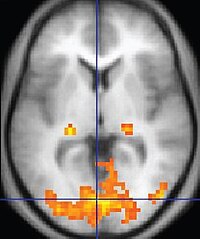
Photo from wikipedia
Objective The potential of neurofeedback to alter the M1-cerebellum connectivity was explored using motor imagery-based rt-fMRI. These regions were chosen due to their importance in motor performance and motor rehabilitation.… Click to show full abstract
Objective The potential of neurofeedback to alter the M1-cerebellum connectivity was explored using motor imagery-based rt-fMRI. These regions were chosen due to their importance in motor performance and motor rehabilitation. Methods Four right-handed individuals were recruited to examine the potential to change the M1-cerebellum neurofeedback link. The University of Glasgow Cognitive Neuroimaging Centre used a 3T MRI scanner from January 2019 to January 2020 to conduct this prospective study. Everyone participated in each fMRI session, which included six NF training runs. Participants were instructed to imagine complicated hand motions during the NF training to raise a thermometer bar's height. To contrast the correlation coefficients between the initial and last NF runs, a t-test was performed post hoc. Results The neurofeedback connection between M1 and the cerebellum was strengthened in each participant. Motor imagery strategy was a significant task in training M1-cerebellum connectivity as participants used it successfully to enhance the activation level between these regions during M1-cerebellum modulation using real-time fMRI. The t-test and linear regression, on the other hand, showed this increase to be insignificant. Conclusion A novel technique to manipulate M1-cerebellum connectivity was discovered using real-time fMRI NF. This study showed that each participant's neurofeedback connectivity between M1 and cerebellum was enhanced. This increase, on the other hand, was insignificant statistically. The results showed that the connectivity between both areas increased positively. Through the integration of fMRI and neurofeedback, M1-cerebellum connectivity can be positively affected.
Journal Title: Computational Intelligence and Neuroscience
Year Published: 2022
Link to full text (if available)
Share on Social Media: Sign Up to like & get
recommendations!